“Cocoa Whole Spelt Puff Pastry” – what a funny word coining, isn’t it ;-). But let’s turn to today’s urban shot first. Last week, we were sitting in a café somewhere in Scheunenviertel. The small streets between Rosa-Luxemburg-Straße and Rosentaler Straße are home to many fashion and accessoire shops, and of course this is one of Berlin’s busy shopping areas where you can get the well known brands and can also make some nice discoveries (two of my favourite shops are located here, one for shoes and one for handbags and wallets).
Having a coffee break in the area the other day, we discovered this remarkable hidden statement right in the middle of it all which no one else seemed to realize:
;-). For my English-speaking readers: „Kaufkraft“ means something like purchasing power.
In today’s recipe, it’s about hidden things and connotations as well. I am sure you know similar situations like the following one: You want to make a nice sweet tarte and you can’t decide which – then you stumble across a recipe for Tarte au riz in your French cookbook and find some forgotten Italian Fregola Sarda (toasted pasta globules from Sardinia) in the back of your kitchen cabinet. Maybe next thing you think is: Why not replacing the rice with Fregola and do a Tarto di riso without riso but roasted pasta – instead of tarte au riz with riz.
Maybe you furthermore spot some organic whole flour puff pastry in your fridge, and you are like: Maybe I don’t make a cake, but prepare little pasties. With a filling made up with quite an amount of milk, eggs, and vanilla, you are close to Pastéis de Nata already. Then you recognize that both the Fregola and the puff pastry show that indefinite beige color that performs horrific both on a plate and in front of a camera. Therefor, you probably go one step further: You have come a long way already with all those sidesteps – why not trying a puff pastry yourself, with beautiful dark brown cocoa, wouldn’t it be nice. Because there’s no cocoa puff pastry to buy, nowhere. You think, there’s maybe a reason for it, and it might probably not work at home either, but in this very moment you remember that fellow blogger Eva of the beautiful blog Kochpoetin has done something similar in a gorgeous Millefeuille recipe (German language).
Let’s now assume, just for a little moment, that you are as much a clumsy patisseur as I am, and you think: this is crazy, I’m not a home-made puff pastry person! But you are trapped already with beautiful imaginations of a lovely, dark brown dough and a smooth contrasting filling, and have something like this on your mind:
Next thing you remember is that another fellow blogger, Sybille of wonderful tomatenblüte, had once linked to a simple express puff pastry recipe within her loveley Juice Pears post (German language). You just can’t find it on her blog in the first place, so you duckduckgo puff pastry and her blog name – and here we are, finally.
Two things are for sure: tiny roasted pasta globules shine perfectly in a sweet environment. And home-made puff pastry is amazing, even if mine had not yet been perfectly flaky. But the taste is much less greasy and more aromatic compared to puff pastry that you can buy at shops (even the whole grain organic). I won’t say it’s that easy and that quickly done, but it’s worth a little effort – if I can manage it with my two left feet, you can too, believe me. Just two questions remain: how should you (or me) name this French-Italian-Portuguese-German crossover? And what is duckduckgo? The former question remains unsolved, but the latter is easily answered: maybe the smartest and cutest digital poultry on the internet.
Enough talk, let’s do the pastry.
Here’s my recipe
Cocoa whole spelt puff pastry
The recipe is based on this article (German language, video included) that Sybille had linked to. I made a few changes regarding cocoa, whole grain flour and more butter and water as whole grain needs more fat and liquid. So if you want to check the original, please follow the link.
For about 18 Pastéis de Nata, you will need:
250 g butter
300 g whole spelt flour (and flour to work with)
40 g cocoa powder
6 g raw sugar
6 g salt
190 ml water
Take the butter, cut into medium size quarters and put into the freezer for 10 minutes to have it really chilly. I did not do so on my first attempt and took the butter just off the fridge – it turned out to be much too soft this way and made the dough really sticky.
Mix whole spelt flour, sifted, cocoa powder, sugar, and salt (I would love to have a slightly sweeter dough next time and will give it a try with maybe 40 g sugar, but I have no idea so far what impact this will have on the texture). Add the water. Mix well with a kitchen machine – I took my hands and it occurred to me that it might be better not do so as the dough gets too warm this way.
Add the cold and firm butter into the dough and mix again loosely – the butter pieces should still show. Put the dough on a floured work surface, add a little flour to the dough and loosely knead with your hands. Put the dough into plastic wrap, flatten the package a bit and let rest in the fridge for 30 minutes. It will look like this:
Take off the fridge, and now comes the funny part – at least to me, you know, the clumsy patisseur thing… You have to fulfill the following legerdemain (I looked up this funny word in my dictionary and I hope, it is halfway appropriate in the given context):
Take the greasy dough and try to roll it out lengthwise with as few additional flour as you can manage. Once you have done so, fold the dough twice like a business letter, so that you get 3 layers of dough. For heaven’s sake: resist the temptation to repeat this right away because you think the dough is too greasy and butter chunky and needs a little more of this procedure to mix in the butter properly… If you do so, you will ruin it – like I nearly did. The butter will get warm, it will be an all-over sticky mess and you will take more flour in to avoid that stickiness and this will make the dough brittle in the end… I told you it’s tricky, didn’t I ;-).
Wipe off spare flour as good as you can manage and wrap the folded dough into some plastic wrap again and put to the fridge for 20 minutes to chill and relax again. What we did now is giving the dough a first tour (is it said like this in English?): rolling, folding, resting. You will have to do this four further times as described, and the direction of rolling will always be to the open sides of the package.
In the end, it will look like this:
You can easily see that I have not been too successful with the wipe-off-spare-flour-thing, but it tasted great in the end nevertheless.
OK, now your dough is ready for take-off (right away or next day – you will need to put it in the fridge in the latter case) and your nerves are hopefully not yet wrecked, because there’s some more work to do ;-). Prepare three muffin baking forms for 6 muffins each (medium size) and grease the forms. Roll out the puff pastry on little flour until it’s about 3-4 mm thick (if it’s thinner it won’t get flaky). With a round cookie cutter or glass of about 10 cm diameter, cut out 18 round pieces of dough and put tightly into the muffin forms. Put the forms into the fridge.
Fregola Sarda filling
The recipe for this follows very loosely a Tarte au riz recipe in this book: Le cordon bleu- Regional French, edited by Kay Halsey. You will need:
1 l full-fat milk (I prefer organic with 3,8 % fat)
200 g raw sugar
1 vanilla bean
150 Fregola Sarda
4 egg yolks
Preheat your oven to 200 °C. In a wide pan, mix milk with sugar, and the pulp of the vanilla bean. Add the halves of the beans as well. Boil the mixture up and add the Fregola Sarda. Boil up again, reduce the heat and let simmer with open lid as long as it takes until the pasta is aldente – it took me about half an hour. Especially when it get’s near the end, make sure that you stir all the time, otherwise you will get skin on top and burnt pasta on the bottom.
The mixture should look like a very creamy pastasotto in the end:
If your mixture get’s too firm but the pasta is not soft enough yet, add a little more milk. Take off the stove. Mix the egg yolks and add one tbsp of the hot Fregola in, mix very well. Do so two more times and then add the egg mixture to the rest of the Fregola. Mix very well again.
I did a further try with the filling with beaten egg white of 4 eggs added to the filling like indicated in the Tarte au riz recipe, but it turned out that I prefer the plain egg yolk version like it is used for Pastéis de Nata . Here are both versions with the egg-yolk-only version on the left:
Interim report
Nearly done… A few remarks before the final steps just to show the possible variations and how they turned out to be, because from here on, I tried different ways. First of all I had a little pre-test with some rice filling directly after I had prepared the dough – this has been the Tarte au riz. For this test, I had blind-baked the dough in two little tarte forms for 15 minutes, then filled it with rice that had been cooked the same way as the fregola and baked it for another 15 minutes. We had not been too content, as the filling got dry and the dough had been very compact still.
Second, on the next day, I did those pasties in the muffin forms. Half of it, I did not blind-bake at all, and the other half, I pre-baked but without blind-baking. The dough rises up if you do it this way which shall normally be avoided, but indeed this had been the best texture so far:
Third attempt had been a little cake which had been due to the fact that I had prepared only two muffin baking forms and there had been a lot of filling and dough left. The cake had been fine as well, but he proportions of dough and filling are of course totally otherwise. For this cake, you need a third of the puff pastry rolled out 4 mm thick. Prebake in a 20 cm springform pan for 10 minutes at 200 °C, fill with half of the fregola filling mixed with 2 beaten egg whites and further bake for 25 minutes. Let cool down and cover with icing sugar.
Before I finally turn to the rest of the recipe for the Pastéis de Nata version that we liked best, here are some pics of the Tarte au riz and the Pasta cake:
Complete the Pastéis de Nata
Take the prepared muffin forms off the fridge. Put into the preheated oven (200 °C) and bake for 5 minutes. Take off, press down carefully the dough in the forms a bit and fill in the Fregola. Put a little raw sugar on top and put into the oven again. Go on baking for 12-15 minutes – it depends how deep you muffin forms are and how quickly or slowly the filling gets firm in it. Take off, let cool down a bit, take off the forms and serve warm with walnut ice-cream or just like this.
By the way: It had been a funny coincidence, that Darya of the wonderful blog Tortore had posted some savory Fregola Sarda dish just one that very day when I had been at that point „why not replacing riz with fregola“ in the what-cake-to-bake-story in the beginning of this post. So, if you want to have some great inspiration what to do with Fregola on the savory path, watch out her gorgeous Fregola sarda ai cannolicchi {Pâtes aux couteaux de mer}.
And now I have finally come to an end with this incredibly long post with an excessive photo presentation. Please, forgive me – it had been all too exciting to realize that I might be a home-made puff-pastry person after all. Maybe. Just on special occasions.

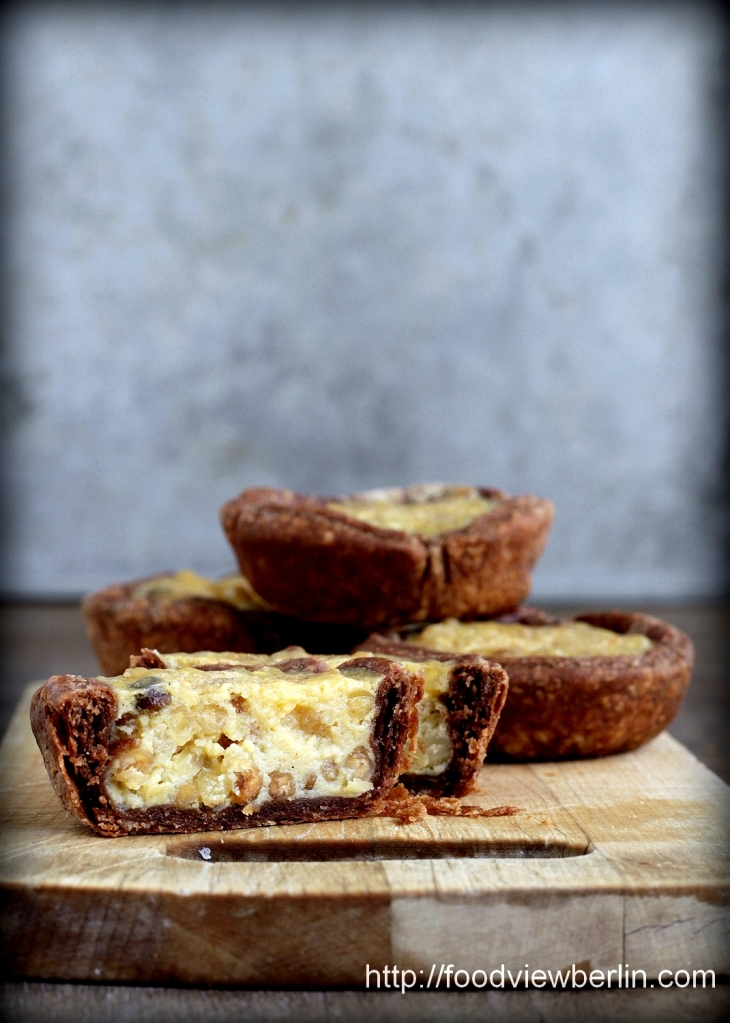
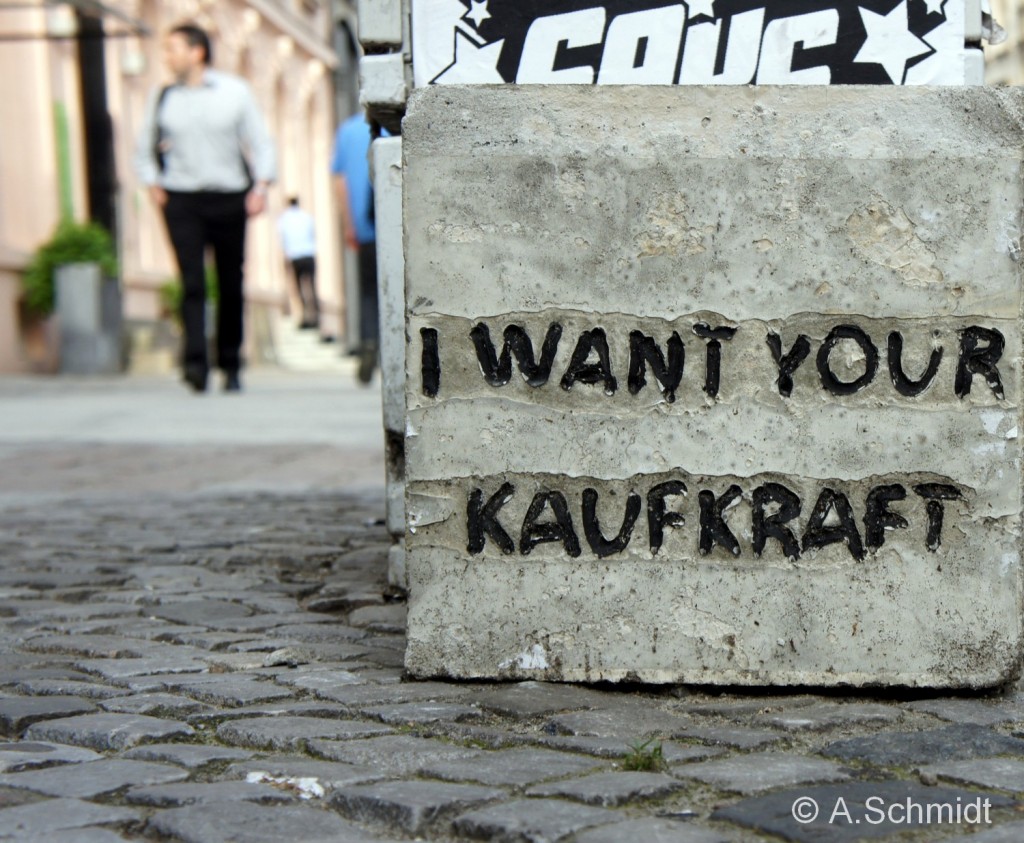

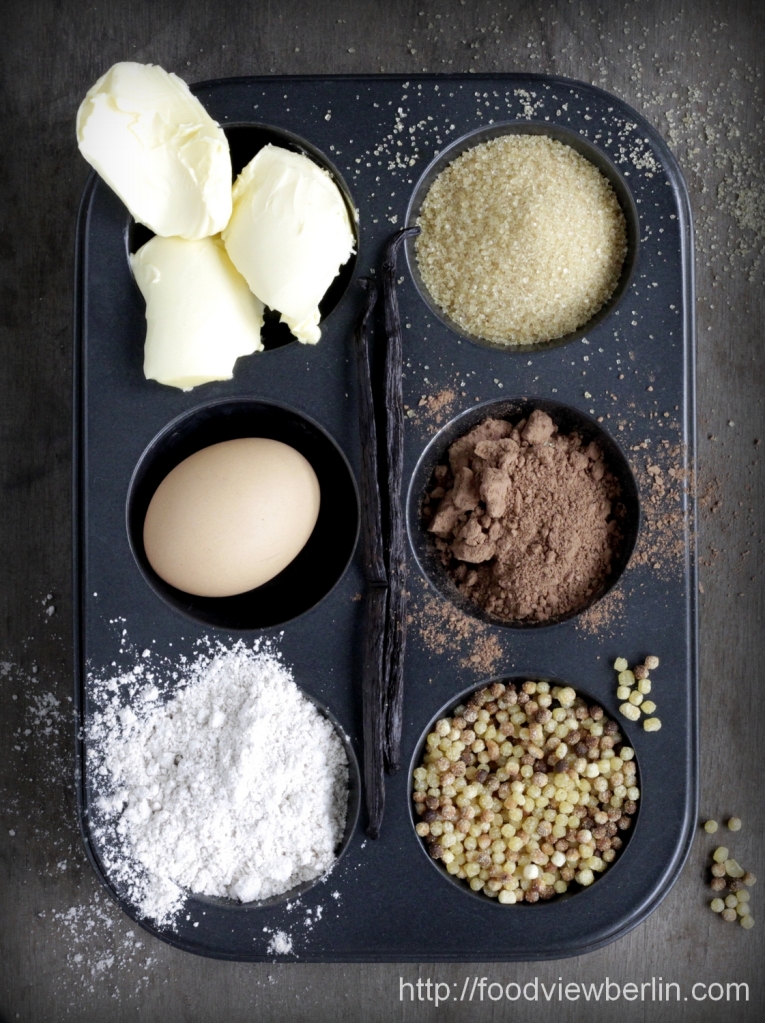
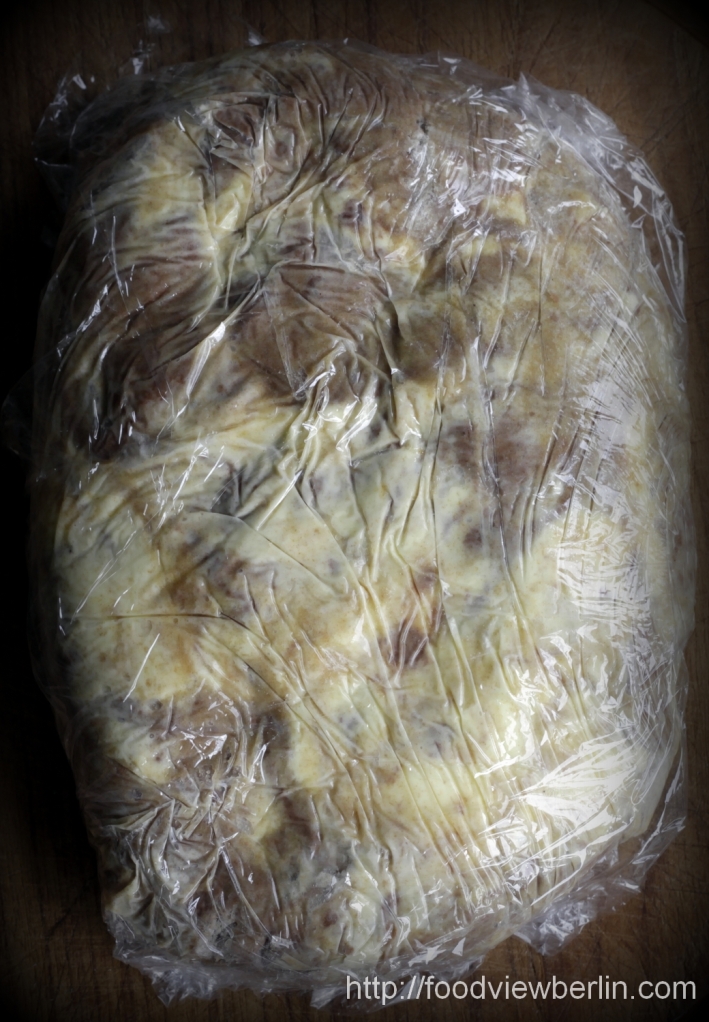
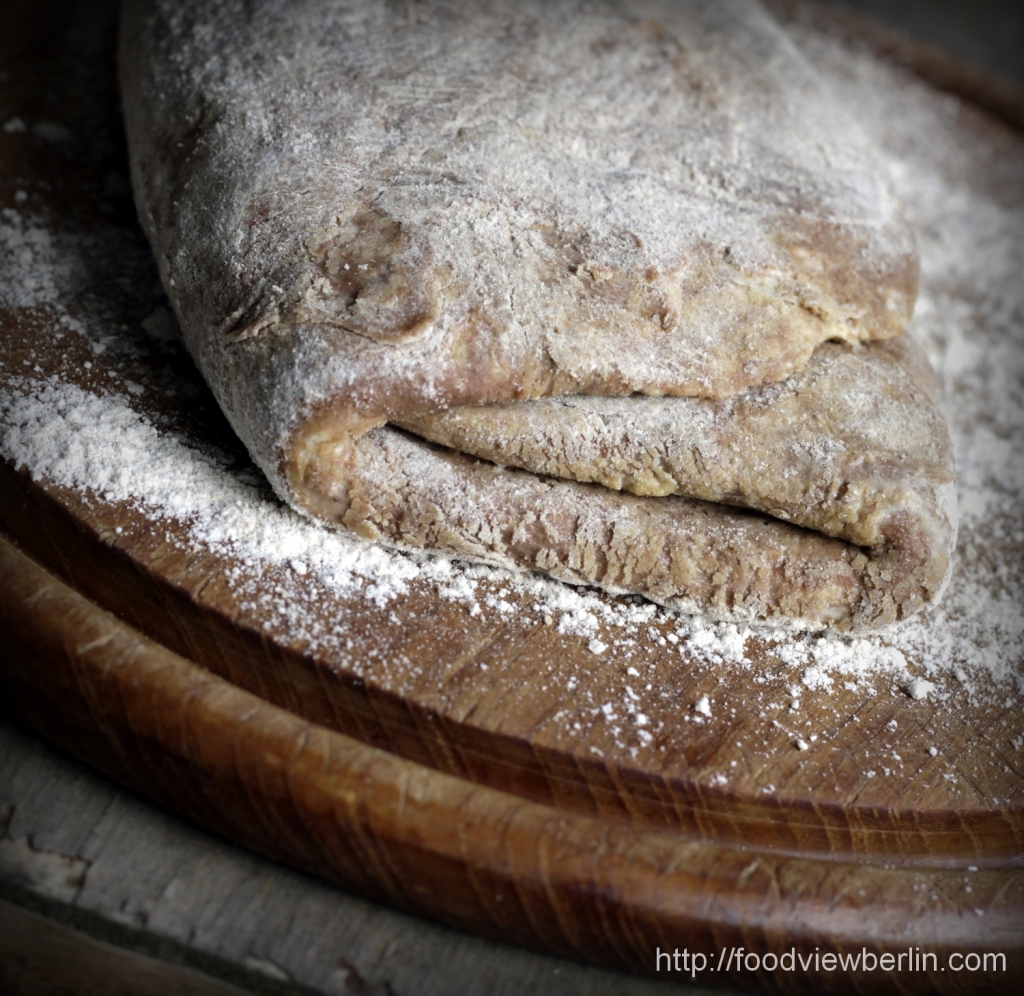
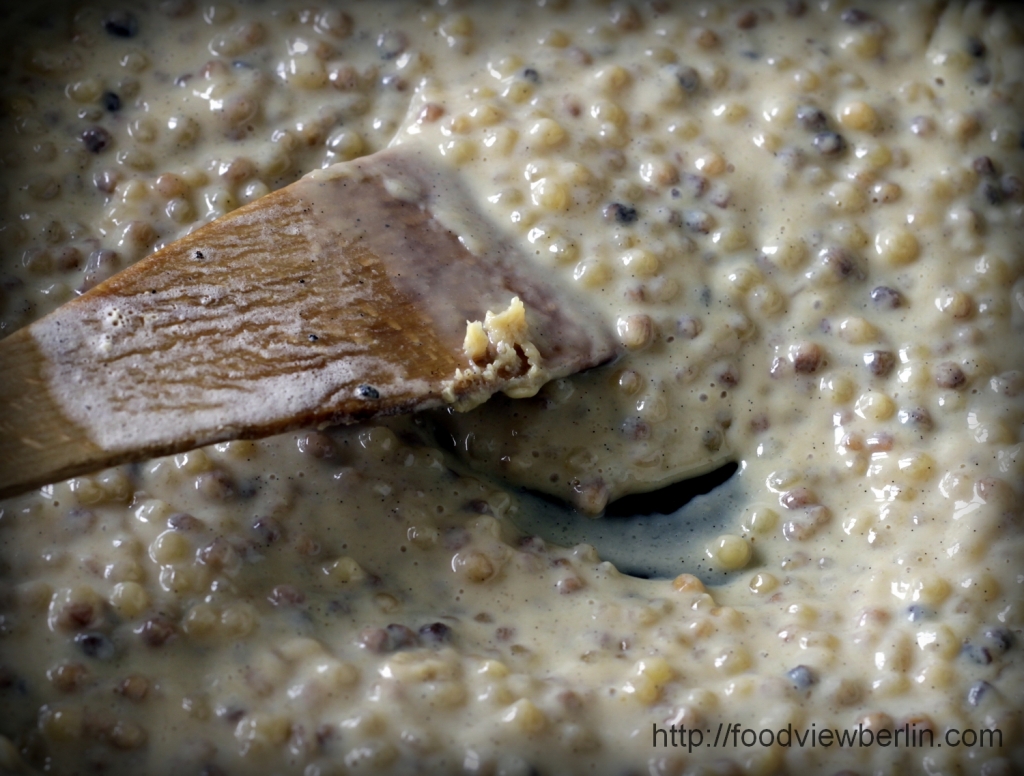








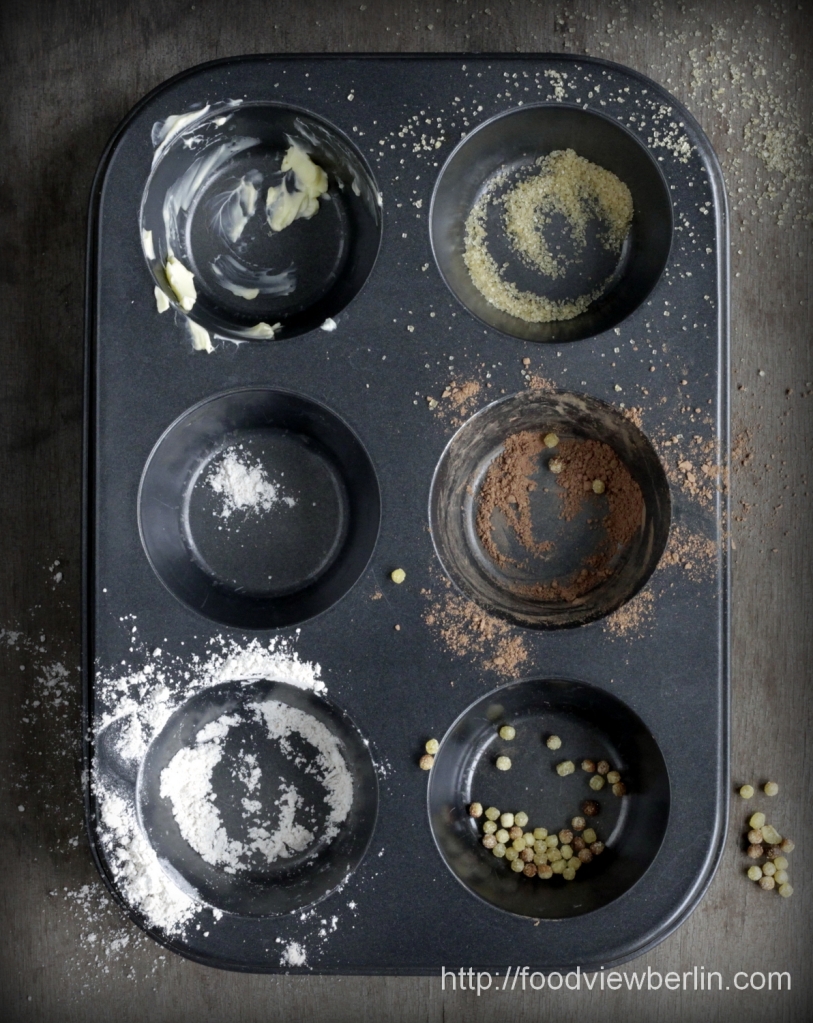
This is just amazing! Very well done, I was like, no, I can’t believe what she did! 🙂 Too bad, that I can’t try one of those nice little fellows without a “proper” name… they look sooo yummy. Right now it’s too hot to make another puff-pastry (never heard of that name as well). But I will definitely do one soon!
As for the find stuff in cupboards and replace, welcome to my world, that’s what I do most of the time not always crowed with success. 😉
And I lov the urban shot, isn’t it wildly ironic?
LikeLike
Thank you so much, Eva! I can’t believe either ;-). I guess I made lots of mistakes nevertheless as a beginner and as a very impatient baker, but indeed we (and some friends as well) just loved the tiny nameless fellows – maybe we should call it Pastéis de Berlin ;-)? I will be most exhited to hear how you will like it if you give it a try!
You are right, the statement on the stone in this environment is enchantingly ironic ;-).
LikeLike
Oh my goodness, what a wonderful post! Unfortunately I’ve forgotten to buy some butter and today there’s no time to make good for it. Otherwise I would prepare your pasties here and now. Looks like another perfect pasty for my collection of food-for-my-journeys-recipes (beside Eva’s cheese pasties). Last week I’ve taken some kind of rice pudding along – next time I will try it with your puff pastry around. Thanks a lot and have a nice day.
LikeLike
Thank you so much (Antje, it’s you I guess?)! You are right, this is just perfect for take-away. Great that you want to try it as well – let me know how you like it! Maybe there are some whole grain flours in your collection that might work even better than spelt.
LikeLike
Wow…..looks like you are going to be a wonderful baker, too! 🙂
As to replacing ingredients – that’s what I do all the time. It’s not always a great success – but it’s part of the fun you have in kitchen. My grandmother and my mother always used to say, looking at recipes: Man nehme – man nimmt 😉
LikeLike
Thank you so much, Susanne. I still feel like a clumsy baker though – but at least like a clumsy baker who doesn’t fear ay more adventurous things like puff pastry ;-).
Wonderful quoting of your mother and grandmother!
LikeLike
Incredible post! How imaginative. I would never have thought of using fregola in a sweet dessert! I wonder what it was like, but I am sure it must have been quite delicious! I have made puff pastry before, but never with cocoa, and never with whole spelt; I probably wouldn’t have risked it, but I love the idea!
And thank you for mentioning my post! 🙂
LikeLike
It has been my pleasure to link to your wonderful recipe, Darya :-).
Thanks a lot for the compliment! Regarding the risky puff pastry you are absolutely right: whole grain behaves much different than white meal as it is heavier – which seems in contradiction to a fluffy light puff pastry. But the long process of preparation helps the flour a lot to get smooth and loose its floury taste. As for the cocoa: it seems to make the dough a bit more brittle, so its better to add some more liquid and/or fat (which I did in my recipe already because of the whole grain).
LikeLike
You are definitely a triple P!! What a crazy idea, again! Du machst einen echt schwach mit deinen irren Kreationen, das ist echt nicht mehr normal. Jedes Mal denkt man, was soll denn jetzt noch kommen!? Aber du setzt immer noch einen drauf. Tolle Sache. Diesen Schokoblätterteig alleine find ich schon spitze.
LikeLike
That’s so sweet Uda, thanks a lot! I gladly return the compliment – you know that you are the creative lunch queen, don’t you :-).
Den Schokoblätterteig kann ich wärmsten empfehlen, es ist ein bisschen Herumgefrickel und daher – und auch ernährungsphysiologisch – nichts für den täglichen Gebrauch. Aber schrecklich lecker. Mit ein bisschen mehr Zucker beim nächsten Mal.
LikeLike
Hi Claudia. Good job on the chocolate puff pastry! I love all the side steps you took to get to this recipe. It looks wonderful. 🙂
LikeLike
Thanks a lot, Puja! Great that you like the recipe.
LikeLike
Congrats on your first puff-pastry!! And I loved the whole mile of your post 😉 I still haven gotten round to making puff-pastry from scratch, even with all the encouragement and mouthwatering posts from Eva. Now you… I think I definitely need to tackle this mission 😉
Apropo Mission. Habe leider immer noch kein Glück auf der Olivenkrautfront 😦 Mein neuster Tippgeber meinte ich sollte mal beim Türken gucken. Auf ein neues 😉
LikeLike
Thank you very much, Emma! Oh yes please, give it a try :-). I have seen recipes on your blog that are more complicated than this – I’m sure you can manage this one way better than me.
Ich habe gestern Olivenkraut erstaunlicherweise in einem ganz normalen Supermarkt gesehen (Reichelt-Edeka). Ich weiß nicht, was ihr in Aachen so an gutsortierten Märkten habt, aber wenn die üblichen Quellen von Wochenmarkt über Bioladen bis Gartencenter es nicht haben, dann würde ich es mal dort versuchen. Viel Erfolg!
LikeLike
Ach so, ganz vergessen: Türkische und andere mediterrane Lebensmittel-Läden könnten das natürlich auch haben, gute Idee von Deinem Tipp-Geber (habe ich bei meinen noch nicht entdeckt, aber das muss ja nichts heißen).
LikeLike
Your on! The pre-dough is sitting in the fridge 😉
LikeLike
You’re really doing it! That’s great :-).
LikeLike
This looks sooo good! And so new and exciting! I love to try new things that I have no idea what they’re gonna taste like (although cocoa does give me an idea.. ;))
LikeLike
Thanks a lot, Yvonne! If you try it I will be so excited to hear how you like it. The taste is a bit like normal Pastéis de Nata which taste of vanilla, and this version adds of course the flavors of cocoa and also some toasted flavors of the fregola to it. As there’s some brown sugar added on top, there’s also a slight caramel taste. I hope this description gives a picture :-).
LikeLike
Sapperlott.( is there an english word for).
Das nenne ich mal eine kreative Idee. Erinnert mich ganz entfernt an Milchreisküchlein. Auf jeden Fall werde ich die Fregola mal als Milchnudeln verkosten…. 🙂 🙂
LikeLike
Unfortunately I don’t know an English translation for the wonderful expression Saperlot ;-).
Danke für Dein Lob, liebe Sybille! Milchreisküchlein sind wahrscheinlich gar nicht mal so weit entfernt – zumal Tarte au riz ja auch das Ausgangsrezept für dieses hier war. Bin gespannt, was Du zu Milch-Fregola sagen wirst.
LikeLike
Köstlich sieht das aus, da muss ich Tomatenblüte ganz zustimmen! 🙂
LikeLike
Lieben Dank, Verena!
LikeLike